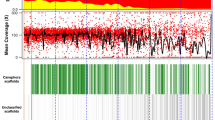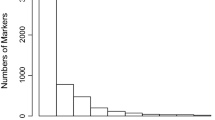Abstract
An EST-based PCR-RFLP method was employed to gain insight into genome organization in eight allopolyploid Coffea arabica cultivars and seven diploid coffee species. The PCR-amplified products at 19 EST loci were digested with 46 different restriction enzymes and size fractioned in agarose gels. Most often, the sum of the fragments length was double or more than the PCR product. In arabica, this condition could be explained by assuming the presence of duplicated loci in paralogous chromosomes and this was supported by considerable evidence of multiple loci SSR amplification. Based on the RFLP analysis, 12 EST loci were polymorphic. The level of polymorphism was higher in different species compared to the arabica varieties. Sequencing of the amplified products revealed a SNP frequency of 0.021 among diploid species and of 0.007 among arabica varieties. We propose that the involvement of two genomes in C. arabica maintains a residual level of heterozygosity in the form of paralogous chromosomes, while the self-fertilization in this species tends to drive of homozygosity. The heterozygosity of paralogous chromosomes in arabica creates valuable polymorphism essential for species diversity and survival in various ecological niches, while self-fertility tends to preserve in homozygosity many genes of functional significance.
Similar content being viewed by others
References
Abbott RJ. 1992. Plant invasions, interspecific hybridization and the evolution of new plant taxa. Trends Ecol. Evol. 7: 401–405
Altschul SF, Madden TL, Schaffer AA, Zhang J, Zhang Z, Miller W, Lipman DJ. 1997. Gapped BLAST and PSIBLAST: A new generation of protein database search programs. Nucl. Acids Res. 25: 3389–3402
Anthony F, Combes MC, Astorga C, Bertrand B, Graziosi G, Lashermes P. 2002. The origin of cultivated Coffea Arabica L.varieties revealed by AFLP and SSR markers. Theor. Appl. Genet. 104: 894–900
Bandopadhyay R, Sharma S, Rustgi S, Singh R, Kumar A, Balyan HS, Gupta PK. 2004. DNA Polymorphism among 18 species of Triticum-Aegilops complex, using wheat ESTSSRs. Plant Sci. 166: 349–356
Blanc G, Barakat A, Guyot R, Cooke R, Delseny M. 2000. Extensive duplication and reshuffling in the Arabidopsis genome. Plant Cell 12: 1093–1101
Butcher PA, Moran GF. 2000. Genetic linkage mapping in Acacia mangium 2. Development of an integrated map from two outbred pedigrees using RFLP and microsatellite loci. Theor. Appl. Genet. 101: 594–605
Charlesworth D, Charlesworth B. 1995. Quantitative genetics in plants: the effect of the breeding system on genetic variability. Evolution 49: 911–920
Chen M, SanMiguel P, de Oliveira AC, Woo SS, Zhang H, Wing RA. 1997. Microcolinearity in the sh2-homologous regions of the maize, rice and sorghum genomes. Proc. Natl. Acad. Sci. USA. 94: 3431–3435
Chen ZJ, Wang J, Tian L, Lee HS, Wang JJ, Chen M, Lee JJ. 2004. The development of an Arabidopsis model system for genome-wide analysis of polyploidy effects. Biol. J. Linnean Soc. 82: 689–700
Clarindo WR, Carvalho CR. 2009. Comparision of the Coffea canephora and C. arabica karyotype based on chromosomal DNA content. Plant Cell Rep. 28: 73–81
Comai L, Tyagi AP, Lysak MA. 2003. FISH analysis of meiosis in Arabidopsis allopolyploids. Chromosome Res. 11: 217–26
Combes MC, Andrzejewski S, Anthony F, Bertrand B, Rovelli P, Graziosi G, Lashermes P. 2000. Characterization of microsatellite loci in Coffea arabica and related coffee species. Mol. Ecol. 9: 1178–1180
Cordeiro G, Eliott F, Mc McIntyre CL, Casu RE, Henry RJ. 2006. Characterization of single nucleotide polymorphisms in sugarcane ESTs. Theor. Appl. Gen. 113: 331–343
Coulibaly I, Revol B, Noirot M. 2003. AFLP and SSR polymer phism in a Coffea interspecific backcross progeny [(C. heterocalyx x C. canephora) x C. canephora]’. Theor. Appl. Genet. 104: 358–366
Cronn R, Small R, Wendel JF. 1999. Duplicated genes evolve independently in allopolyploid cotton. Proc. Nat. Acad. Sci. USA 96: 14406–11
Cronn R, Small R, Haselkorn T, Wendel JF. 2003. Choloroplast and nuclear DNA from the New World cotton Gossypium gossypioides record two ancient hybridization events. Proc. Natl. Acad. Sci. USA. 100: 4649–4654
Cros J, Combes MC, Chabrilange N, Dupperray C, Monnot des Angles A, Hamon S. 1995. Nuclear DNA content in the subgenus Coffea (Rubiaceae): inter and intraspecific variation in African species. Can. J. Bot. 73: 14–20
Cros J, Combes MC, Trouslot P, Anthony F, Hamon S, Charrier A, Lashermes P. 1998. Phylogenetic relationship of Coffea species: new evidence based on the chloroplast DNA varia tion analysis. Mol. Phylogenet. Evol. 9: 109–117
Da Silva JAG, Sorrells ME. 1996. Linkage analysis in polyploids using molecular markers. In PP Jahuar, ed, Methods of Genome Analysis in Plants, CRC Press, Boca Raton, USA, pp 201–228
Davis AP, Govaerts R, Bridson DM, Stoffelen P. 2006. An annotated taxonomic conspectus of the genus Coffea (Rubiaceae. Bot. J. Linnean Soc. 152: 465–512
De Nardi B, Dreos R, Del Terra L, Martellossi C, Asquini E, Tornincasa P, et al. 2006. Differential responses of Coffea arabica L. leaves and roots to chemically induced systemic acquired resistance. Genome 49: 1594–1605
Douabin-Gicquel V, Soriano N, Ferran H, Wojcik F, Palierne E, Tamim S, Jovelin T, McKie AT. 2001. Identification of 96 single nucleotide polymorphisms in eight genes involved in iron metabolism: efficiency of bioinformatic extraction compared with a systematic sequencing approach. Hum. Genet. 109: 393–401
Grivet L, Glaszmann JC, Arruda P. 2001. Sequence polymer phism from EST data in sugarcane: a fine analysis of 6-phosphogluconate dehydrogenase genes. Gen. Mol. Biol. 24: 161–167
Ilic K, SanMiguel PJ, Bennetzen JL. 2003. A complex history of rearrangement in an orthologous region of the maize, sorghum and rice genomes. Proc. Natl. Acad. Sci. 100: 12265–12270
Isobe S, Gau M, Yamaguchi H, Uchiyama K, Maki Y, Matsuura M, Ueda S, Sawai A, Tshushumi M, Takeda Y. 2002. Breeding of red clover ‘Natsuyu’ and its characteristics. Res. Bull. Hokkaido Natl. Agric. Exp. Stn. 177: 13–21
Lashermes P, Cros J, Marmey P, Charrier A. 1993. Use of random amplified DNA marker to analyze genetic variability and relationship of Coffea species. Genet. Resour. Crop Evol. 40: 91–99
Lashermes P, Combes MC, Robert J, Trouslot P, D’Hont A, Anthony F. 1999. Molecular characterization and origin of the Coffea arabica L. genome. Mol. Gen. Genet. 261: 259–266
Lexer C, Lai Z, Rieseber LH. 2004. Candidate gene polymerphisms associated with salt tolerance in wild sunflowerhybrids: implications for the origin of Helianthus paradoxus, a diploid hybrid species. New Phytol. 161: 225–233
Luo MC, Dubcovsky J, Dvorak J. 1996. Recognition of homeology by the wheat Ph1 locus. Genetics 144: 1195–1203
Masterson J. 1994. Stomatal size in fossil plants: Evidence for polyploidy in majority of angiosperms. Science 264: 421–424
Murray MG, Thompson WF. 1980. Rapid isolation of high molecular weight plant DNA. Nucl. Acids Res. 8: 4321–4325
Ming R, Liu SC, Lin YR, da Silva J, Wilson W, Braga D. 1998. Detailed alignment of Saccharum and Sorghum chromosomes: comparative organization of closely related diploid and polyploid genomes. Genetics 150: 1663–1682
Orozco-Castillo C, Charmers KJ, Powell RW. 1994. Detection of genetic diversity and selective gene introgression in coffee using RAPD markers. Theor. Appl. Genet. 87: 934–940
Pearl HM, Nagai C, Moore PH, Steiger DL, Osgood RV, Ming R. 2004. Construction of a genetic map for arabica coffee. Theor. Appl. Genet. 108: 829–835
Poncet V, Hamon P, Minier J, Carasco-Lacombe C, Hamon S, Noirot M. 2004. SSR cross-amplification and variation within coffee trees (Coffea spp). Genome 47: 1071–1081
Poncet V, Hamon P, Sauvage De Saint Marc M.B, Bernard T, Hamon S, Noirot M. 2005. Base composition of Coffea AFLP sequences and their conservation within the genus. J. Hered. 96: 59–65
Quiros CF. 1998. Molecular markers and their applications to genetics, breeding and the evolution of Brassica. J. Jpn. Soc. Hort. Sci. 67: 1180–1185
Rieseberg LH, Sinervo, B, Linder CR, Ungerer MC, Arias DM. 1996. Role of gene interactions in hybrid speciation: Evidence from ancient and experimental hybrids. Science 272: 741–745
Rieseberg LH, Raymond O, Rosenthal, DM, Lai Z, Livingstone K, Nakazato T. 2003. Major ecological transitions in annual sunflowers facilitated by hybridization. Science 301: 1211–1216
Rovelli P., Mettulio R., Anthony F. Anzueto F., Lashermes P, Graziosi G. 2000. Microsatellites in Coffea arabica L. In International seminar on biotechnology in the coffee agroin dustry, 3, Londrina, Coffee biotechnology and quality; proceedings, Dordrecht, Kluwer Academic Publishers, pp 123–133
Rozen S, Skaletsky H. 2000. Primer3 on the www for general users and for biologist programmers. Meth. Mol. Biol. 132: 365–386
Sambrook J, Fritsch EF, Maniatis T. 1989. Molecular cloning, 2nd Ed. Cold Spring Harbor Laboratory Press, New York
Schumacher K, Schondelmaier J, Barzen E, Steinrucken G, Borchardt D, Weber WE, Jung C, Salamini F. 1997. The combination of different linkage maps in sugar beet (Beta vulgaris L.) into one map. Plant Breed. 116: 23–38
Sewell MM, Sherman BK, Neale DB. 1999. A consensus map for loblolly pine (Pinus taeda L.) I. Construction and integration of individual linkage maps from two outbreed three-generation pedigree. Genetics 151: 321–330
Silvarolla MB, Mazzafera P, Fazuoli LC. 2004. A naturally decaffeinated arabica coffee. Nature 429: 826–826
Simillion C, Vandepoele K, Van Montagu MCE, Zabeau M, Van de Peer Y. 2002. The hidden duplication past of Arabidopsis thaliana. Proc. Natl. Acad. Sci. USA. 99: 13627–13632
Simko I, Haynes KG, Jones RW. 2006. Assessment of linkage disequilibrium in potato genome with single nucleotide polymorphism markers. Genetics 173: 2237–2245
Soltis DE, Soltis PS. 1993. Molecular data and the dynamic nature of polyploidy. Crit. Rev. Plant Sci. 12: 243–273
Soltis DE, Soltis PS. 1999 Polyploidy: recurrent formation and genome evolution. Trends Ecol. Evol. 14: 348–352
Soltis PS, Soltis DE. 2000. The role of genetic and genomic attributes in the success of polyploids. Proc. Natl. Acad. Sci. 97: 7051–7057
Stebbins GL. 1966. Chromosomal variation and evolution. Science 152: 1463–1469.
Sterck L, Rombauts S, Jansson S, Sterky F, Rouze P, Van de Peer Y. 2005. EST data suggest that poplar is an ancient polyploidy. New Phytol. 1671: 165–170.
Tornincasa P, Dreos R, De Nardi B, Asquini E, Devasia J, Mishra MK, Del Terra L, Pallavicini A, Graziosi G. 2006. Genetic diversity of commercial coffee (C. arabica L.) from America, India and Africa assessed by simple sequence repeats (SSRs). Proceedings of the 21st international associate ion for coffee science (ASIC). Montpellier, France, pp 778–785
Xu WW, Sleper DA, Chao S. 1995 Genome mapping of poly ploid tall fescue (Festuca arundinacea Schreb.) with RFLP markers. Theor. Appl. Gent. 91: 947–955
Xu Y, Zhu L, Xiao J, Huang N, McCouch SR. 1997 Chromosomal regions associated with segregation distortion of molecular markers in F2, backcross, doubled haploid, and recombinant inbred populations in rice (Oryza sativa L.). Mol. Gen.Genet. 253:535–545
Author information
Authors and Affiliations
Corresponding author
Rights and permissions
About this article
Cite this article
Mishra, M.K., Tornincasa, P., De Nardi, B. et al. Genome organization in coffee as revealed by EST PCRRFLP, SNPs and SSR analysis. J. Crop Sci. Biotechnol. 14, 25–37 (2011). https://doi.org/10.1007/s12892-010-0035-6
Received:
Revised:
Accepted:
Published:
Issue Date:
DOI: https://doi.org/10.1007/s12892-010-0035-6




